Unicolonial ants pose challenge to "selfish gene" theory.
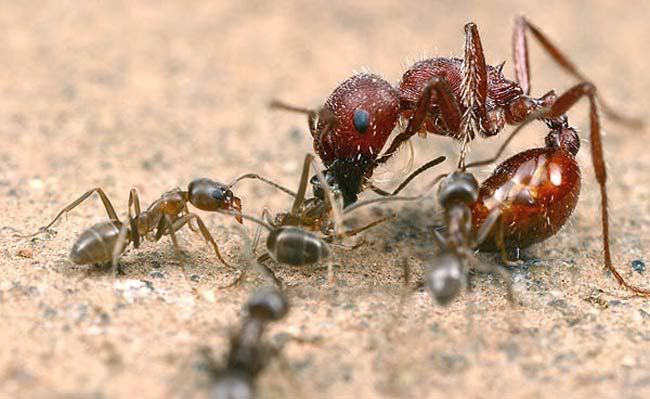
Unicolonial ants, such as these Argentine ants (Linepithema humile), are genetically unrelated but will cooperate to defeat a much larger adversary.
Source: Alex Wild / Live Science
However, both of these scenarios break down where it comes to unicolonial ants. In a new paper in the journal Trends in Ecology and Evolution (subscription required) Heikki Helantera, of the University of Sussex, and colleagues at Rice University have investigated how previous theories to explain cooperation don't apply for these unique supercolonies.
Unicolonial ants carry polydomy [multiple nests in a supercolony that all individuals rotate through] and polygyny [multiple queens in one nest] to extremes. Colonies are huge, each being a network of hundreds or thousands of nests, each with multiple queens. There is no worker aggression, and there is free movement among nests on a vast scale. The energy that might have been put into fighting and territoriality flows into the common good, more ants.Such a concept, a form of genuine anarchism in the animal world, was thought to be impossible given existing theory. These ants live in colonies where relatives exist but, with so much migration throughout a network stretching thousands of kilometers, each ant worker is mostly surrounded by total strangers that share none of their genes. Only one other species has ever been known to organize themselves in such a fashion (and if you're reading these words right now you know who you are).
To understand how unicolonial ants have come to be the way they are, we must first understand what they're not. Kin selection has proposed that cooperation will emerge in groups that are made up of close relatives. Hamilton's rule, beautiful in its simplicity, proposed that cooperation occurs when the cost to the actor (C) is less than then the benefit to the recipient (B) multiplied by the genetic relatedness between the two (r). This equation is written out simply as rB > C.

Lion siblings often cooperate as teams and benefit through kin selection.
Source: Scotch Macaskill / Wildlife Pictures.com
To put this into context: an alpha male lion and his brother share half of their genes, so have a genetic relatedness of 0.5. Suppose this brother recognizes that the alpha male is getting old and could easily be taken down. If so, the brother could potentially have eight additional cubs (just to pull out an arbitrary number). But, instead, that brother decides to help the alpha male to maintain his position in the pride and, as a result, the alpha ends up having the eight additional cubs himself while the brother only has five. The brother has lost out on 3 potential cubs. But, even so, because he assisted his brother he has still maximized his overall reproductive success from a genetic point of view: (0.5) x 8 = 4 > 3. He could have attempted to usurp his brother and, perhaps, had the eight cubs himself but he wouldn't have been in any better of a position as far as his genes were concerned.
Reciprocal altruism follows this same basic idea, but proposes a mechanism that could work for individuals that are unrelated. In this scenario, cooperation occurs when the cost to the actor (C) is less than the benefit to the recipient (B) multiplied by the likelihood that the cooperation will be returned (w) or wB > C. This has been demonstrated among vampire bats who regurgitate blood into a stranger's mouth if they weren't able to feed that night. Previous experience has shown the actor that they're likely to get repaid if they ever go hungry one night themselves. This theory requires that individuals be part of a single group, with low levels of immigration and emigration, so that group members will be likely to encounter each other on a regular basis.
Previously, it was argued that all ants followed an extreme form of kin selection. Because of their unique process of reproduction females develop from fertilized eggs and have paired chromosomes (that is, one from each parent). However, males develop from unfertilized eggs and only have a single chromosome from their mother. As a result, female workers share up to 75 percent of their genes with sisters but only 50 percent with their mother (or their own offspring, if they were to reproduce). Worker ants therefore have greater genetic success by not reproducing but, instead, helping to raise and protect their legion of closely related sisters.
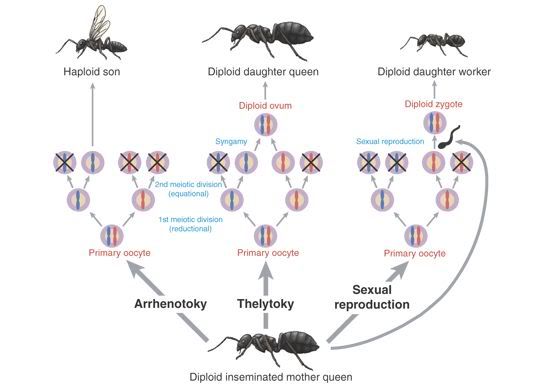
Ant reproduction gives rise to genetic sisterhood.
Source: Unattributed
This explanation has been somewhat clouded given more recent evidence that queens engage in polyandry (mating with multiple males). A queen will frequently mate with up to five different males and store their combined sperm, around 100 million of them, in a special compartment called the spermatheca. By releasing a single sperm at a time the queen can control the number of eggs she lays. However, because there are multiple fathers, the genetic relationship between the female worker ants is reduced. Female workers may therefore only be related by 25 percent with the females they're helping to raise. Why would female workers continue to be non-reproductive and help rear distant relatives when they could have twice the reproductive success by having their own offspring? While there are strategies female workers employ to maximize their own reproductive success (like preferrentially rearing eggs that they are more closely related to or, in some rare cases, reproducing themselves) it still remains puzzling why ants have been so successful given this seeming contradiction.
If you add to this the realities of multiple queens in a single nest (polygyny) and supercolonies that are composed of thousands of such nests (polydomy), the problem becomes insurmountable. If worker ants share zero percent of their genes with those they're cooperating with, as is the case in these unicolonies, then why cooperate? What do they have to gain?
This is the problem that Helantera and colleagues are seeking to understand in their latest paper. While the authors emphasize a range of possible explanations, I want to focus on just one that has been generating a great deal of interest in the last few years: group selection.
The extreme cooperation of unicolonial ants has been suggested to be an example of selection occurring on levels higher than the individual, such as the superorganism, group or even population.Group selection is the idea that, under certain circumstances, genes will be selected for because they benefit the overall success of the group rather then simply the individual. While it is usually assumed that these populations will have a high level of relatedness (making the promotion of the group an extended form of kin selection) the authors suggest a scenario in which group selection could apply even among unrelated group members.
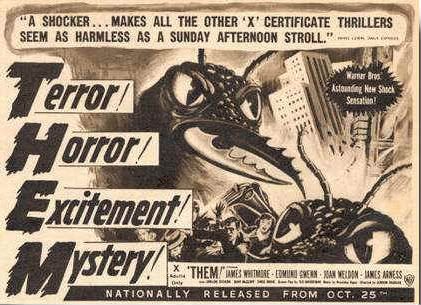
Giant ants terrorize humanity in Them!.
Source: Warner Bros.
This is a possibility I like to call Ronald Reagan's Alien Invasion Hypothesis. In a speech before the United Nations on Sept. 21, 1987 Reagan stated that:
In our obsession with antagonisms of the moment, we often forget how much unites all the members of humanity. Perhaps we need some outside, universal threat to make us recognize this common bond. I occasionally think how quickly our differences worldwide would vanish if we were facing an alien threat from outside this world.So under this possibility a common threat to all colony members would outweigh the low level of genetic similarity because, unless everyone pulls together, the entire group is in jeopardy. If one colony was competing with a rival colony then selection for individual selfishness could drive the population to extinction while selection for cooperation would allow the colony to thrive.
Under this view, extant unicolonial populations are the ones that have not yet succumbed to selfishness. Relatedness and mutual policing select against selfishness in non-unicolonial populations, but stop applying when relatedness decreases to zero. . . [However], constraints arising from the natural history of the species or pleiotropic effects of selfish genes, might prevent selfish genotypes from arising even under zero relatedness.This cooperation could then continue long after the initial threat was gone under the force of phylogenetic inertia. Perhaps, in the future, selection would cause the unicolony to break into smaller, more genetically similar colonies once the impetus for group selection no longer exists? Or perhaps the benefits of cooperating with strangers simply outweighs the costs of competition and natural selection has produced a genuinely altruistic society?
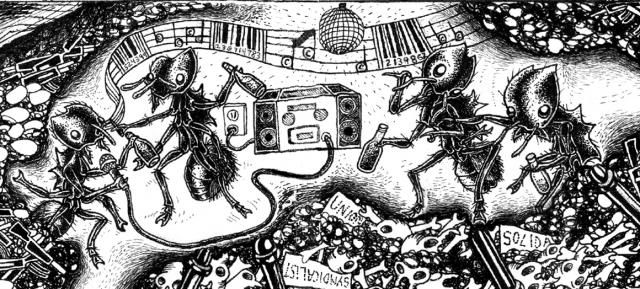
Unicolonial cooperation has inspired activist art such as this print from the Beehive Collective.
Source: Beehive Collective
At the current time there are 31 known unicolonial ant populations around the globe. This is a small minority given the more than 12,000 described species. However, given that research on unicolonial ants is so new, there is still a great deal of research that needs to take place concerning this unique experiment of the natural world. At the very least, unicolonies provide us with a source of inspiration and the ability to marvel at the amazing beauty and diversity of the natural world. With the knowledge that stable supercolonies composed of strangers continue to thrive in nature, perhaps there's something we could learn from those creatures that first invented this approach.
References:
Hamilton, W.D. (1964). The genetical evolution of social behaviour I and II. — Journal of Theoretical Biology 7: 1-16 and 17-52
Trivers, R.L. (1971). The evolution of reciprocal altruism. Quarterly Review of Biology. 46: 35-57.
Helantera, H., Strassman, J.E., Carrillo, J., Queller, D.C. (2009). Unicolonial ants: where do they come from, what are they and where are they going? Trends in Ecology and Evolution. doi:10.1016/j.tree.s009.01.013


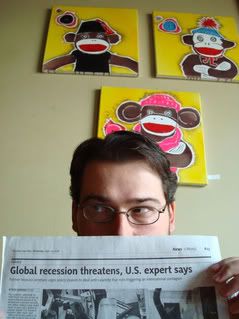















9 comments:
thanks for a thoughtful and uplifting well written post. that truly altruistic behavior is found in other creatures encourag
...es us to search for it within ourselves
I can't help but think that there must be some individual component to this. Perhaps these ants' survival is so dependent upon the cohesion of the colony, that they've evolved a sort of formicay morality where they have impulses to cooperate with each other and to punish cheaters.
What I find most fascinating is the anarchistic nature of these colonies. The workers aren't cooperating because of a "mandate" from the queen. In fact, the only hierarchies (as far as I know) in these ant colonies are the ones imagined by us as we watch them through human society colored glasses.
Uh, you know of course that Bert Holldobler and E.O. Wilson have a book out this year entitled " The Superorganism by W.W. Norton & co.
I was at a talk a few years ago by a Dane, who managed to describe the behaviour of this ant's supercolony as group selection, without once mentioning the term. He knew it, we knew it, but nobody felt able to utter the term in public. Good to see were finally getting over the excesses of the 70s.
One other thing that was brought up in the talk (I don't know if Heikki mentions it in TREE) was that in it native range the ant doesn't form super-colonies very often. It looks like what happens is that free-loaders evolve, and the system collapses. It struck me that the invasives might just be waiting for the freeloaders to appear.
How sure are we that there isn't genetic relatedness? Could it be that the ants tend to mate amongst themselves, creating genetic flow through the supercolony, thus, the "strangers" might be, if not siblings, at least cousins?
@ranka: The genetic relatedness is assuredly very low. With multiple queens (each mating with multiple males) in a single nest and thousands of nests in which workers move about freely, the authors estimate that for the majority of individuals the relatedness to other workers is 0%. Assuming there are a low number of queens in one nest (say only 3) that would still mean that 2/3 of the workers in the nest had no genetic relationship with the other third. When that third is dispersed throughout the entire colony, the majority of individuals each worker encounters would most likely be a stranger. This migration would still pose a problem even if all three queens were siblings.
How can you claim that kin selection breaks down in the case of unicolonial ants when the abstract of the paper quoted as evidence of breakdown says:
"However, recent genetic and behavioral data show that, viewed on a sufficiently large scale, unicolonial ants do have colony boundaries that define very large kin groups. It seems likely that they are family groups that continue to express their kin-selected behavior as they grow to extreme sizes. However, at extreme sizes, kin selection theory predicts that these behaviors are maladapted and evolutionarily unstable, a prediction that is supported by their twiggy phylogenetic distribution."
Do they recant the abstract in the body of the article?
I think it's fair enough if you positively *disagree* with their interpretation of their experimental results - but I think it's reasonable to expect someone to lead with that, if they are making a case based on the results from an experimental paper.
Marios
Nice to see our paper raises debate, although I have to say I was surprised when a colleague pointed me to a blog where I am quoted as saying non-hamiltonian things!
As an author of the paper, I have commented on these issues on another thread on the same blog.
http://scienceblogs.com/primatediaries/2009/09/unicolonial_ants_pose_challeng.php
A couple of additional mentions:
Marios: the abstract of our paper gives a fair idea of the point we make in the whole paper. The group selection mention we make is a little side-track.
Bob: while we do not go too deep in to the invasiveness issue in our review (done in depth by Andy Suarez, Ted Case, David Holway, Neil Tsutsui and others elsewhere), it is true that in their native ranges supercolonies are smaller than in the invasive ranges, and compete with each other. This in may often make the relatedness in the native range higher than zero.
The invasive supercolonies at least should be vulnerable to both freeloaders and the inefficiency of natural selection on worker traits in the absence of relatedness between the individuals that carry the trait, and the queen that reproduces.
Heikki
Post a Comment